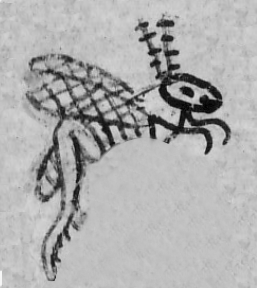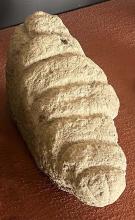chapolin (Mxnus35)
This black-line drawing of the element chapolin (grasshopper) has been extracted from the compound place name Chapoltepec. The grasshopper, as in the example from the Codex Mendoza, is quite detailed in the face, body (striped), wings (mesh), antennae (hairy), and legs (bent). It is shown here in profile, facing toward the viewer's right.
Stephanie Wood
The level of detail on this grasshopper suggests that artists had great familiarity with the insect and probably studied it very closely. The patterns on the femurs and lower abdomen (spiracles) are very much like those captured in this photo, https://news.okstate.edu/articles/agricultural-sciences-natural-resource.... The immediately recognizable, bent leg that allows the grasshopper to hop appears by itself as a signature glyph for Chapulicxitlan (representing chapolin, grasshopper, and icxitl, foot) on folio 8 recto of the Codex Mendoza. Detailed, concrete knowledge of this insect may be owing to the fact that the chapolines (as they are called in Mexican Spanish) were (and still are) consumed as food. They come in many sizes. They can be eaten in tacos or mixed with other ingredients. Chile and salt are often added. Because they were collected, sold in the marketplace, and consumed, people were very familiar with them and saw the close up.
Stephanie Wood
ca. 1590
Jeff Haskett-Wood
chapulines, chapulín, grasshoppers, insectos, insects, comida, Chapultepec
This museum object from the archaeological site of Guachimontones, Jalisco, greatly resembles other museum sculptures of the chapolin (see, for example, these two https://aztecglyphs.wired-humanities.org/sites/default/files/compreal/Ch... and
https://aztecglyphs.wired-humanities.org/sites/default/files/compreal/Sc.... Photo by S. Wood, 16 April 2025.

chapolin, grasshopper, https://nahuatl.wired-humanities.org/content/chapolin
https://www.loc.gov/resource/gdcwdl.wdl_15284/?sp=35&st=image. This image is hosted by the Library of Congress and the World Digital Library, but the manuscript is part of the holdings of Bibliothèque nationale de France and the original source is gallica.bnf.fr/BNF.
The non-commercial reuse of images from the Bibliothèque nationale de France is free as long as the user is in compliance with the legislation in force and provides the citation: “Source gallica.bnf.fr / Bibliothèque nationale de France” or “Source gallica.bnf.fr / BnF.”



